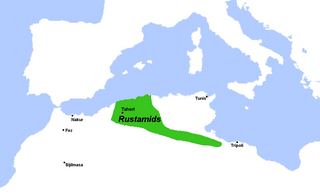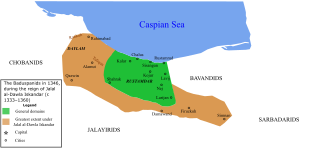Related Research Articles

The Tahirid dynasty was an Arabized Sunni Muslim dynasty of Persian dehqan origin that ruled as governors of Khorasan from 821 to 873 as well as serving as military and security commanders in Abbasid Baghdad until 891. The dynasty was founded by Tahir ibn Husayn, a leading general in the service of the Abbasid caliph al-Ma'mun. For his support of al-Ma'mun in the Fourth Fitna, he was granted the governance of Khorasan.

The Saffarid dynasty was a Persianate dynasty of eastern Iranian origin that ruled over parts of Persia, Greater Khorasan, and eastern Makran from 861 to 1002. One of the first indigenous Persian dynasties to emerge after the Islamic conquest, the Saffarid dynasty was part of the Iranian Intermezzo. The dynasty's founder was Ya'qub bin Laith as-Saffar, who was born in 840 in a small town called Karnin (Qarnin), which was located east of Zaranj and west of Bost, in what is now Afghanistan. A native of Sistan and a local ayyār, Ya'qub worked as a coppersmith (ṣaffār) before becoming a warlord. He seized control of the Sistan region and began conquering most of Iran and Afghanistan, as well as parts of Pakistan, Tajikistan and Uzbekistan.

The Rustamid dynasty was an Ibadi Persian dynasty centered in present-day Algeria. The dynasty governed as a Muslim theocracy for a century and a half from its capital Tahert until the Ismaili Fatimid Caliphate defeated it. Rustamid authority extended over what is now central and western Algeria, parts of southern Tunisia, and the Jebel Nafusa and Fezzan regions in Libya as far as Zawila.

Muhammad I Tapar, was the sultan of the Seljuk Empire from 1105 to 1118. He was a son of Malik-Shah I and Taj al-Din Khatun Safariya.

The Samanid Empire was a Persianate Sunni Muslim empire, ruled by a dynasty of Iranian dehqan origin. The empire was centred in Khorasan and Transoxiana, at its greatest extent encompassing northeastern Iran and Central Asia, from 819 to 999.

Abū Muḥammad ʿAlī ibn Aḥmad ibn Ṭalḥa ibn Jaʿfar ibn Muḥammad ibn Hārūn al-Muktafī bi'Llāh, better known by his regnal name al-Muktafī bi-Llāh, was the caliph of the Abbasid Caliphate from 902 to 908. More liberal and sedentary than his militaristic father al-Mu'tadid, al-Muktafi essentially continued his policies, although most of the actual conduct of government was left to his viziers and officials. His reign saw the defeat of the Qarmatians of the Syrian Desert, and the reincorporation of Egypt and the parts of Syria ruled by the Tulunid dynasty. The war with the Byzantine Empire continued with alternating success, although the Arabs scored a major victory in the Sack of Thessalonica in 904. His death in 908 opened the way for the installation of a weak ruler, al-Muqtadir, by the palace bureaucracy, and began the terminal decline of the Abbasid Caliphate that ended in 946 with the caliphs becoming puppet rulers under the Buyid dynasty.

Abū al-Manṣūr Muḥammad ibn Aḥmad ibn Ṭalḥa ibn Jaʿfar ibn Muḥammad ibn Hārūn al-Qāhir bi'Llāh, usually known simply by his regnal title al-Qahir bi'Llah, was the nineteenth caliph of the Abbasid Caliphate from 932 to 934. He was born 286 AH and died 339 AH.

The Qarmatians were a militant Isma'ili Shia movement centred in Al-Ahsa in Eastern Arabia, where they established a religious—and, as some scholars have claimed, proto-socialist or utopian socialist—state in 899 CE. Its members were part of a movement that adhered to a syncretic branch of Sevener Ismaili Shia Islam, and were ruled by a dynasty founded by Abu Sa'id al-Jannabi, a Persian from Jannaba in coastal Fars. They rejected the claim of Fatimid Caliph Abdallah al-Mahdi Billah to imamate and clung to their belief in the coming of the Mahdi, and they revolted against the Fatimid and Abbasid Caliphates.

Abhar is a city in the Central District of Abhar County, Zanjan province, Iran, serving as capital of both the county and the district. Abhar has historically served as a place of importance due to lying right between the cities of Qazvin and Zanjan.
Nasr I was amir of the Samanids from 865 to 892. He was the son and successor of Ahmad ibn Asad.

The Kakuyids were a Shia Muslim dynasty of Daylamite origin that held power in western Persia, Jibal and Kurdistan. They later became atabegs (governors) of Yazd, Isfahan and Abarkuh from c. 1051 to 1141. They were related to the Buyids.

Rawwadid, Ravvadid, or Banū Rawwād (900–1071) was a Sunni Muslim Kurdish dynasty, centered in the northwestern region of Adharbayjan (Azerbaijan) between the late 8th and early 13th centuries.

Amr ibn al-Layth or Amr-i Laith Saffari was the second ruler of the Saffarid dynasty of Iran from 879 to 901. He was the son of a whitesmith and the younger brother of the dynasty's founder, Ya'qub ibn al-Layth al-Saffar.

The Afrighids were a native Khwarezmian Iranian dynasty who ruled over the ancient kingdom of Khwarazm. Over time, they were under the suzerainty of the Sasanian Empire, the Hephthalite Empire, the Göktürk Khaganate, the Umayyad Caliphate, Abbasid Caliphate and the Samanid Empire.
The Yazidids or Mazyadids or Shaybanids, were an Arab family what came to rule over the region of Shirvan in the mid 9th century. Starting from Haytham ibn Khalid's assumption of the ancient Iranian title of Shirvanshah in 861, they practically broke free of Abbasid control and was therefore out of scope for most chroniclers of the Caliphate.

Abū Muḥammad al-Ḥasan ibn Zayd ibn Muḥammad ibn Ismaʿīl ibn al-Ḥasan ibn Zayd, also known as al-Dāʿī al-Kabīr, was an Alid who became the founder of the Zaydid dynasty of Tabaristan.

The Baduspanids or Badusbanids, were a local Iranian dynasty of Tabaristan which ruled over Ruyan/Rustamdar. The dynasty was established in 665, and with 933 years of rule as the longest dynasty in Iran, it ended in 1598 when the Safavids invaded and conquered their domains.

Abu'l-Hasan Ali ibn Muhammad ibn Musa ibn al-Hasan ibn al-Furat was a senior official of the Abbasid Caliphate who served three times as vizier under Caliph al-Muqtadir. Ali emerged into prominence as an able fiscal administrator and deputy to his older brother Ahmad. Eventually he came to lead one of the two major and rival court factions during al-Muqtadir's caliphate, the Banu'l-Furat, the other being the group of officials around the commander-in-chief Mu'nis al-Muzaffar and the vizier Ali ibn Isa al-Jarrah.
The Abbasid dynasty or Abbasids were an Arab dynasty that ruled the Abbasid Caliphate between 750 and 1258. They were from the Qurayshi Hashimid clan of Banu Abbas, descended from Abbas ibn Abd al-Muttalib. The Abbasid Caliphate is divided into three main periods: Early Abbasid era (750–861), Middle Abbasid era (861–936) and Later Abbasid era (936–1258). A cadet branch of the dynasty also ruled as ceremonial rulers for the Mamluk Sultanate (1261–1517) until their conquest by the Ottoman Empire.
Abu Muhammad Yahya ibn Aktham was a ninth century Arab Islamic jurist. He twice served as the chief judge of the Abbasid Caliphate, from ca. 825 to 833 and 851 to 854.
References
- ↑ Bosworth, C.E. (2004). The New Islamic Dynasties: A Chronological and Genealogical Manual. Edinburgh University Press. p. 205. ISBN 9780748621378 . Retrieved 2015-08-13.